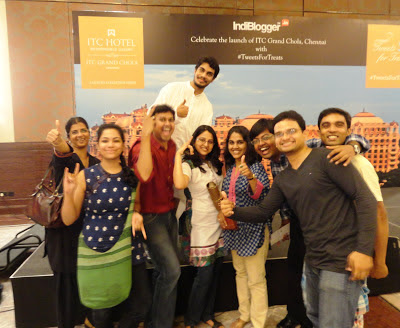 |
| A part of the Chennai Super Bloggers Team - Winners of the First Indian Bloggers League! |
A blogger meet organised by Indiblogger is something every blogger looks out to- as a perfect opportunity to meet, greet and rub shoulders with the wonderful people who are known through their writing, with awesome venues, great food and lots of fun thrown in as a bonus.
This time round, the Indiblogger meet provided a sneak preview into Asia's largest hotel, the ITC Grand Chola at Guindy and it was little wonder that 95% of the registrants reached despite the really short notice.
When I reached the venue, the car was guided along to circumambulate the hotel to reach the Chola entrance, and believe me, it was like circumambulating the Big Temple at Thanjavur! All along the walls, were motifs of elephants (machine cut, and not handmade as I had visualised)welcoming the visitors.
One good thing about the Grand Chola is the pre-reception lobby containing escalators on either side, which enable users of the banquet halls and restaurants to move upstairs without having to enter the main reception!
How efficient!
The indiblogger meet was organised at the Rajendra Banquet Hall, a pillarless wonder that can house upto 3000 people if the panels were all opened up or could be divided into eight smaller conference halls.
 |
| Rajendra outside the Banquet Hall |
The hospitality of ITC was amazing. With unlimited welcome drinks doing the rounds, the participants settled down comfortably in the round tables, which had i-pads configured for bloggers to participate in the #TweetsForTreats competition organised as part of the launch, whereby winners get awesome treats for innovative tweets about the hotel.
The Marketing head of ITC Grand Chola made a brief presentation about the hotel and its special features and it was indeed amazing to note that the entire hotel was operated on wind energy and this was achieved by the numerous windmills installed in Salem.
After a warm up round of HUR...HUR....HURRAY, and some fun questions by Anoop about the capabilities of the I-pads in the ITC Grand Chola hotel rooms, that earned participants experience vouchers of Rs.500 each (self included :)) and a musical chair to the tune of Gangnam Style, we were all set to enjoy the awesome hi-tea which was almost a meal, and the royal guided tour of the hotel with our charming hostess Meghna.
The Suites have been named after Karikala and Rajaraja, the Board rooms after Kaveri and Thanjavur and the Banquet Hall after Rajendra. The Sangam Lobby has a lotus motifed ceiling with acoustics planned in such a way that the voice of a person who spoke below it was magnified. This, we were told was an inspiration from the durbar halls of the Chola Kings (!) where such an arrangement existed, so that everyone heard when the King spoke.
Our tour started at the Sangam Lobby, resplendent with marble, the curving staircases fit enough for a king. We were told that different types of marble from many parts of the world were used liberally in the construction of the hotel as the Cholas had used marble to build palaces and temples. (Is that true? I thought the Mughals had specialised in using marble for construction).
 |
| The Sangam Lobby with the splendid chadeliers and the lovely staircase |
We went through the different entrances - the Kili entrance for the Serviced apartments and the Sembian entrance for the Conference facilites.
We peeped into the restaurants and coffee shops - Madras Pavilion, Cafe Mercara, and Ottimo,
had a lovely mocktail at the Tranque"bar"- a bar named after Tharangambadi of the Chola Kingdom,
breezed through Cheroot - the Malt and Cigar Bar and Nutmeg, the wonderful chocolate and cake place,
and the Kayakalp Spa, before checking out the Tower Room, where every move was "I-Pad" controlled, the spacious Gym and the lovely swimming pool.
 |
| Sipping a Mocktail at the Tranque"bar" |
The die-hard Chola fan in me was a little disappointed that other than the antique artifacts from different parts of India, there was no other symbol or reference from the Cholas in the restaurants or rooms - but then, I guess they have done the best they could, considering business priorities. It would also help immensely if the staff were given a lesson in Chola history so that they are able to relate and narrate facts better.
Meghna told us that the Sembian entrance was named after Sembianmadevi, a queen who was well known for her hospitality! I could not resist telling her that the Cholas took the name of Sembian, to show that they were descendants of King Sibi and Sembianmadevi was well known for her philanthropy and devotion to Lord Shiva and that she had spent many an year in her life and a huge part of her wealth in renovating Shiva temples and in popularising the thevaram! (Phew!)
Bottomline: I decided not to apply too much of history and to enjoy the ambience that had been so meticulously put together by several thousands of people!
I do not want to go into repeating every single detail that Meghna told us, to spoil the fun for those who want to check out the regal splendor and responsible luxury of this hotel that spans over 6,00,000 sq. ft, but here are some glimpses of images that stayed in my mind long after I went home!
That Wonderful Grand Chola Experience! - Through my eyes! Do read the description of each picture, to understand more about the unique features of this magnificient hotel.
A sincere thanks to Indiblogger and ITC Grand Chola for a wonderful fun-filled evening, great food, and lovely treats to take away as parting gifts! We will be back soon to enjoy the regal ambience yet again! May the glory of the Cholas live on!












